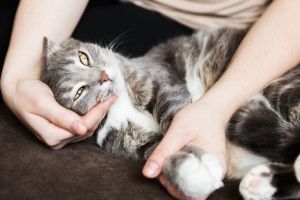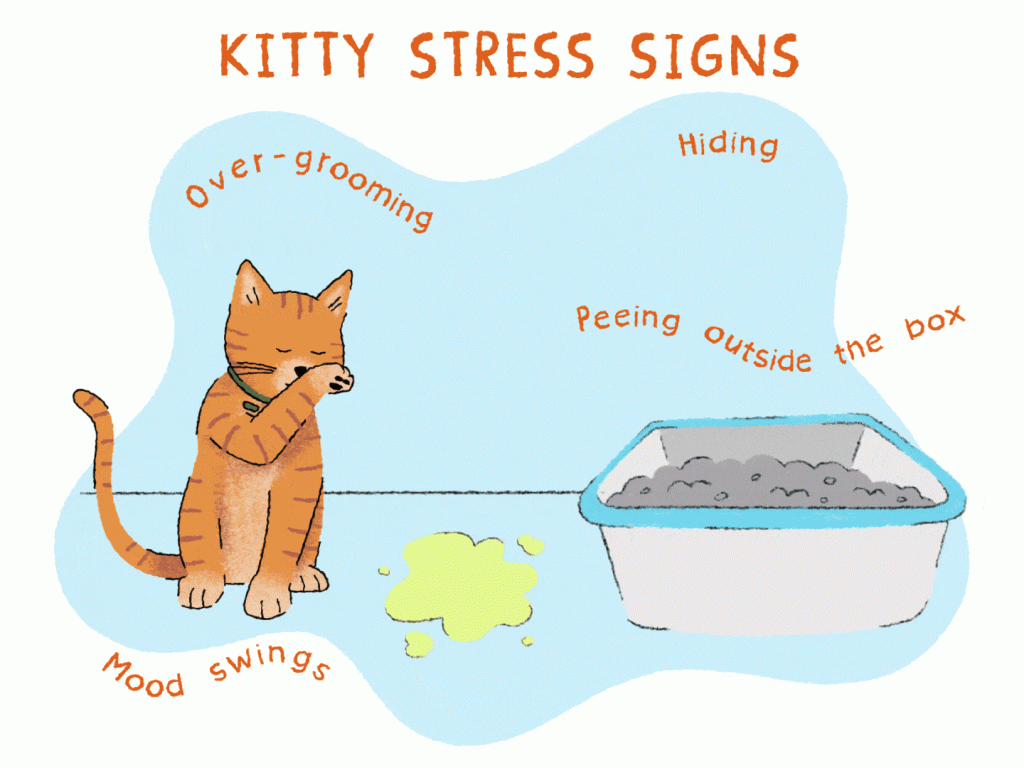Have you ever returned home to find your cat acting out of character? Maybe your usually calm feline is frantically pacing, meowing loudly, or scratching at the furniture.
You might be wondering what’s causing this change in behavior. It could be separation anxiety. Understanding what triggers these anxious feelings in your cat is crucial for a happy, harmonious home. Imagine the relief of knowing exactly how to soothe and support your furry friend.
By the end of this article, you’ll be equipped with the signs to watch for and practical steps to help your cat feel more secure when you’re away. Dive in to discover how you can turn your home into a sanctuary of comfort for your beloved pet.

Credit: www.hickoryvet.com
Common Symptoms Of Cat Separation Anxiety
Cats may show separation anxiety through excessive meowing, destructive behavior, or inappropriate urination. These signs often appear when the owner is absent. Understanding these symptoms can help address your cat’s needs effectively.
Is your feline friend a bit more than just a cute ball of fur? Cats, like humans, can experience anxiety, especially when left alone. Understanding the common symptoms of cat separation anxiety can help you address these issues and provide your pet with the comfort they need. Let’s dive into some of these telltale signs.
Excessive Meowing
Have you ever noticed your cat meowing more than usual when you’re about to leave? This could be a sign of separation anxiety. Cats often use vocalization as a way to express their distress. Keep an ear out for persistent meowing, yowling, or crying as these can be indicators of anxiety. If your normally quiet cat suddenly turns into a chatterbox, it’s worth considering their emotional state. You might wonder, how much meowing is too much? Trust your gut; if it feels excessive, it probably is.
Destructive Behavior
Returning home to find your couch scratched or your favorite vase shattered can be frustrating. But before you scold your furry friend, consider that this could be a cry for help. Destructive behavior is a common symptom of separation anxiety in cats. They may scratch furniture, chew on plants, or knock over objects when they are stressed. Think of your cat’s destructive actions as a way for them to cope with their anxiety. Addressing the underlying issue can often lead to a calmer, more peaceful home environment. Have you noticed any of these behaviors? It might be time to take a closer look at your cat’s emotional well-being. Recognizing these symptoms early can make all the difference in ensuring your pet feels safe and loved.
Behavioral Changes
Cats might show separation anxiety through excessive meowing, destructive behavior, or changes in eating habits. They may become unusually clingy or hide when you’re preparing to leave. Observing these signs helps identify if your cat struggles with being alone.
Understanding the behavioral changes in your cat is crucial to identifying separation anxiety. Cats, much like humans, can exhibit distinct signs when they’re stressed or anxious. Recognizing these changes early can help you take the necessary steps to ease their discomfort.
Increased Aggression
Has your usually sweet cat suddenly started hissing, scratching, or biting? Increased aggression can be a sign of anxiety. When you’re gone, your cat may feel abandoned or threatened, causing it to lash out more than usual. I once noticed my cat, Whiskers, becoming aggressive whenever I returned home after a long day. It was his way of expressing that my absence was distressing. Try to observe if your cat’s aggression is linked to your comings and goings. This insight can be critical in understanding your cat’s emotional state.
Avoidance Or Hiding
Is your cat suddenly spending more time under the bed or in closets? Avoidance or hiding can be another telltale sign of separation anxiety. Cats often retreat to a safe, confined space when they’re anxious. When my friend adopted a new work schedule, her cat started hiding more frequently. This behavior indicated that the cat felt insecure without her presence. Take note of your cat’s hiding habits. Are they hiding when you’re about to leave or after you’ve been gone for a while? Such patterns can provide clues about their anxiety triggers. Recognizing these behavioral changes can be the first step in helping your cat feel more secure. Have you noticed any other unusual behaviors in your cat? Identifying these can lead to a happier and healthier feline friend.
Physical Indicators
Cats often show signs of separation anxiety through physical indicators. Excessive grooming or scratching can signal distress. Other indicators include loss of appetite or unusual aggression.
Have you ever wondered if your cat might be feeling anxious when you’re not around? Understanding the physical indicators of separation anxiety in cats can help you address their needs effectively. Cats often exhibit noticeable changes in their behavior when they miss their owners, and these changes can manifest physically. Recognizing these signs early on can make a significant difference in your cat’s well-being.
Changes In Eating Habits
A cat’s eating habits can tell you a lot about their emotional state. If your cat starts eating less or skips meals entirely, it might be a sign of anxiety. On the flip side, some cats might overeat when stressed. You might notice your cat finishing their food too quickly or seeking more food than usual. Pay attention to any drastic changes. They might be communicating their discomfort with your absence.
Altered Sleep Patterns
Cats are known for their love of sleep, but anxiety can interrupt their regular snooze schedule. If your cat is sleeping much more or less than usual, it might be an indicator of stress. You may find your cat awake and restless during times they usually sleep. This change in behavior can be a cue that your cat is not as relaxed as they should be. Imagine coming home to a cat that’s either too sleepy or overly active. These shifts in energy levels can signal that your furry friend misses you more than you think. Have you noticed any of these physical indicators in your cat? Addressing these signs can help foster a happier environment for them. By tuning into these changes, you can better understand and support your feline friend when separation anxiety creeps in.
Environmental Factors
Understanding the environmental factors that contribute to your cat’s separation anxiety is crucial. Cats are sensitive creatures, and even subtle changes in their surroundings can trigger stress. Recognizing these factors can help you create a more comforting environment for your furry friend.
Changes In Routine
Cats thrive on routine. A sudden shift in your daily schedule can unsettle them. Have you recently altered your work hours or started a new hobby that keeps you away from home more often? Your cat might feel anxious due to the unpredictability of your absence. Consistency is key. Consider establishing a reliable routine that includes regular feeding times and play sessions.
One evening, I decided to switch my cat’s feeding time due to my new gym schedule. The next morning, I found her nervously pacing around her feeding bowl. It was a clear sign that she missed the comfort of her usual routine. Maintaining a predictable schedule can reassure your cat and alleviate her anxiety.
Presence Of Triggers
What triggers your cat’s anxiety when you’re away? Is it the sound of the door closing or the sight of your suitcase? Identifying these triggers is essential. You might notice your cat hiding or displaying unusual behavior when certain events occur. Try removing or minimizing these stressors to ease her anxiety.
Consider using calming aids like pheromone diffusers or soft music. I once left a radio on low volume, playing classical tunes, and noticed it helped soothe my cat during my absence. Creating a tranquil environment can be a game-changer for your anxious pet.
Think about the objects and sounds in your home. Are there any that tend to upset your cat? Sometimes, a simple adjustment can make a big difference in her comfort level.
Have you ever wondered if your cat’s anxiety could be linked to something in her environment? Observing her reactions can provide valuable insights into what she finds distressing. By addressing these factors, you can create a space where she feels secure even when you’re not around.
Emotional Responses
Cats may show separation anxiety through excessive meowing, destructive behavior, or clinginess. Watch for changes in their eating habits or litter box use. These signs indicate your cat might feel stressed when alone.
Emotional responses in cats can be a clear indicator of separation anxiety. Cats may display certain behaviors that signal distress when their owners are away. Understanding these emotional cues can help identify if your feline friend is experiencing anxiety issues.
Excessive Clinginess
Does your cat follow you everywhere? This might be a sign of excessive clinginess. Cats with separation anxiety often seek constant attention. They may sleep near you or sit on your lap more than usual. This clingy behavior is a way of feeling secure. It’s their method of ensuring you’re not leaving them alone. Cats may also vocalize more. You might notice increased meowing or purring. This vocal behavior is a plea for reassurance. They are trying to communicate their need for closeness.
Signs Of Depression
Depression in cats is another emotional response linked to separation anxiety. Look for changes in activity levels. A once playful cat may become lethargic. They might lose interest in toys or activities they once enjoyed. Eating habits can change too. Some cats eat less when they feel sad. Others might overeat. These changes indicate emotional distress. Pay attention to grooming habits as well. Cats might neglect grooming or overgroom to cope. These signs reflect their struggle with being alone.

Credit: www.instagram.com

Credit: www.pawmaw.com
Frequently Asked Questions
Is My Cat Having Separation Anxiety?
Your cat may have separation anxiety if it shows excessive meowing, destructive behavior, or litter box issues when alone. Clinginess and changes in appetite or grooming can also be signs. Consult a vet for proper diagnosis and advice.
How Do You Tell If Your Cat Is Too Attached?
Signs of over-attachment in cats include excessive meowing, following you everywhere, and distress when alone. They may demand constant attention, show separation anxiety, or refuse to eat if you’re absent. Observe behavior changes to assess attachment levels. Consider consulting a vet if the attachment seems extreme or disruptive.
What Are The Signs Of A Stressed Cat?
A stressed cat may show signs like excessive grooming, hiding, aggression, or changes in appetite and litter habits. Watch for increased vocalization or unusual behaviors. Recognizing these signs early can help address the issue promptly and improve your cat’s well-being.
Do Cats Get Sad When You Leave For Vacation?
Cats can feel sad when you leave for vacation. They may miss your presence and daily interactions. To ease their stress, provide toys, familiar scents, and a trusted caregiver. This helps maintain their routine and comfort while you’re away, ensuring their well-being and happiness.
Conclusion
Recognizing separation anxiety in cats helps ensure their well-being. Notice the signs like excessive meowing or destructive behavior. These indicate distress when you’re away. Providing comfort can ease their anxiety. Try leaving familiar items with your scent. Gradually increase alone time to build their confidence.
Consult a vet for persistent issues. They can offer tailored advice or recommend treatments. Prioritizing your cat’s mental health strengthens your bond. Remember, a calm, happy cat is a healthy companion. Stay observant and proactive. Your efforts make a difference in your cat’s life.
